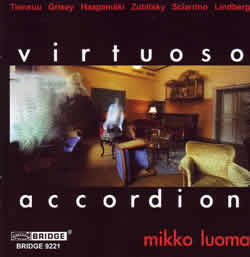The Free-Reed Review
Critiques of Compact Discs, Books and Music
Scores
CD Review: Mikko Luoma: Virtuoso Accordion

total time: 65:34
recorded: Summer 2006
review date: September 2007
|
Virtuoso Accordion
Selections
| 1 | Sampo Haapamäki (b. 1979): Power (2001) (9:06) |
| 2 | Jukka Tiensuu (b 1948): Aufschwung (1977) 8:07 |
| 3-6 | Vladimir Zubitsky (b 1953): Carpathian Suite (1974) 13:59
- Andante severo, molto imperioso
- Vivacissimo, molto preciso
- Moderato assai, quasi adagio
- Festivo, a piacere
|
| 7 | Salvatore Sciarrino (b. 1947): Vagabonde blu (1998) 11:48 |
| 8 | Gérard Grisey (1946-1998): Passacaille* (1967) |
| 9 | Magnus Lindberg (b. 1958): Jeux d'anches (1990/91) 8:44 |
| 10 | Jukka Tiensuu (b 1948): Zolo (2002) 8:37 |
| *world premiere recording |
|
Review by Robert Stead:
Virtuouso Accordion presents just that: compositions that tax the sonic and expressive capabilities of the accordion. Mikko Luoma demonstrates that he is a virtuous accordionist
by meeting the challenge of each composition. He states in the CD notes:
My choice of pieces on this CD was inspired by the many differing but fundamental characteristics of the accordion. The composers herein have shown me, and I trust,
my listeners, what an amazing instrument the accordion is.
Luoma actually fulfills this goal with the first piece, Power, which opens with a powerful statement of a four note motif. This motif recurs throughout the piece
and provides the anchor for the flurry of notes that make this composition dynamic.
I found the Carpathian Suite most intriguing. Zubitsky captures both the melodic heritage of the Ukranian Carpathia as well as the spirit of the people and place. Luoma breathes vibrant life into this piece.
While listening to Vagabonde blu I began thinking about Jack Nicholson's ordering of a chicken salad sandwich in the 1970
movie “Five Easy Pieces”: hold the mayonaise, hold the butter, hold the lettuce, hold the chicken—the minimalist sandwich. Vagabonde blu holds the melody, holds the harmonic progression, holds the beat. What's left is predominately air and silence. Luoma interprets well the sparse material presented here.
Gérard Grisey's Passacaille demonstrates that one can breathe fresh life into a centuries old form. Grisey is true to the passacaglia formula. He begins the piece with a clearly stated theme in the bass (the ostinato) and repeats that theme throughout the composition. Sometimes the ostinato appears in the bass and sometimes in the treble, but it remains unmodulated. Above, around, and through the obstinate theme (the literal meaning of 'ostinato') fly a flurry of motifs that counter the stability of the foundation.
Magnus Lindberg's Jeux d'anches was inspired by the reed pipes of the pipe organ. In fact, “jeux d'anches” means “reed stop”. Lindberg states:
The exceptionally large dynamic and tonal spectrum of the accordion, its “virtuoso potential” arising from the way the manuals are constructed, its harmonic
and polyphonic scope and characteristics of bellows handling, compared to the bowing of a string instrument, make this an utterly fascinating instrument for me.
Jukka Tiensuu has said: "I do not write music because of a composer's perceived duty to add to the concert repertoire continuously. In our age, every single work has to have a specific reason for being created."
(reference: http://www.counterinduction.com/bio.php?personID=000001) Perhaps the reason for Zolo was two-fold: to tax the limitations of the instrument and to pay tribute to the Russian composer Zolotaryov (whose name [or a least a portion of it] is found in the title). The work begins with bellow tremolos and these tremolos are sustained throughout the piece. This piece has also been recorded by Luoma's teacher, Matti Rantanen. Both accordionists masterfully execute the tremolos as well as the pitch bending and long phrasing that makes this piece especially difficult.
I would say that Mikko Luoma has accomplished the goal that he set for this CD. His superb interpretation of these contemporary pieces has demonstrated how amazing the accordion is.
